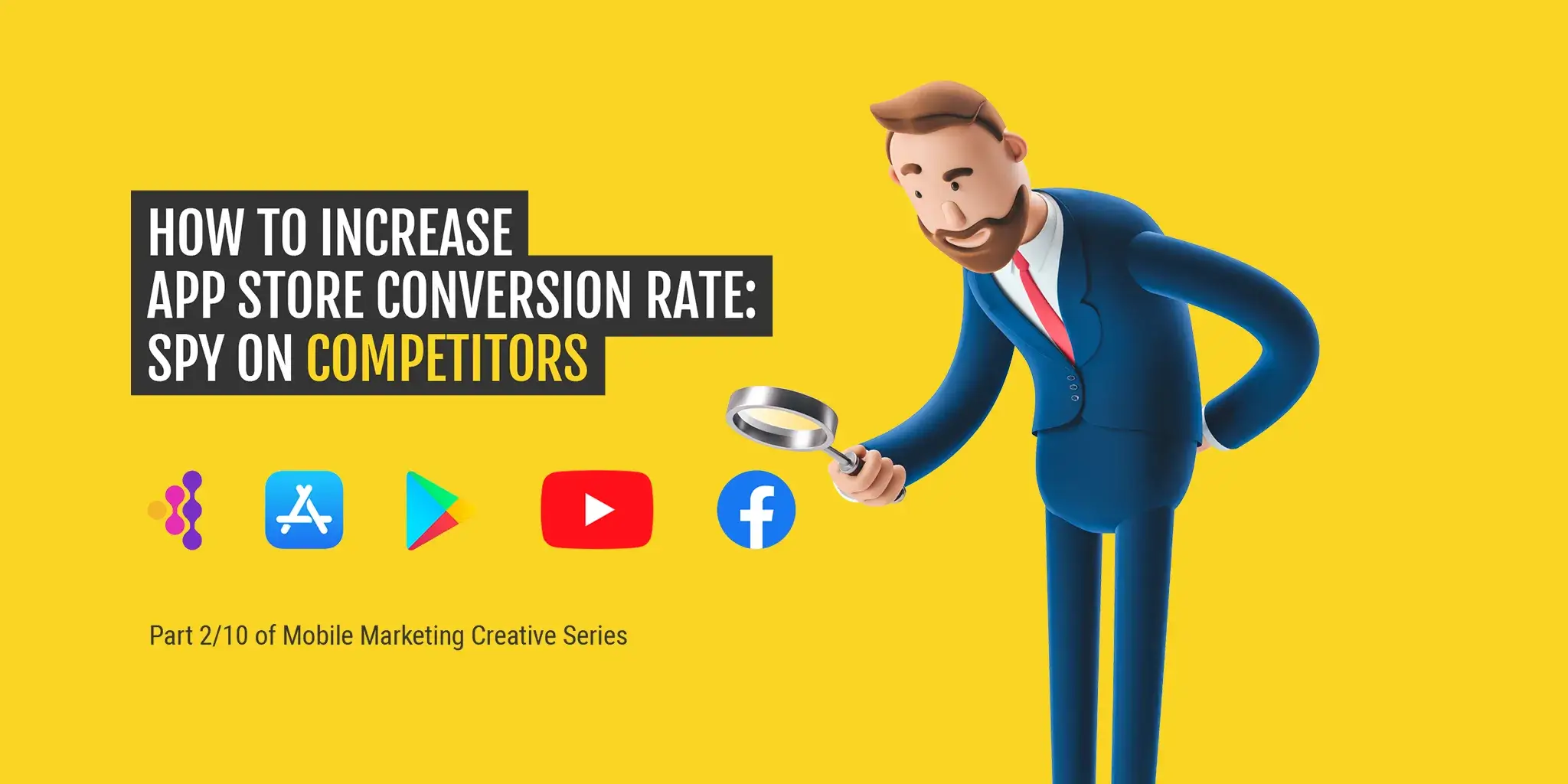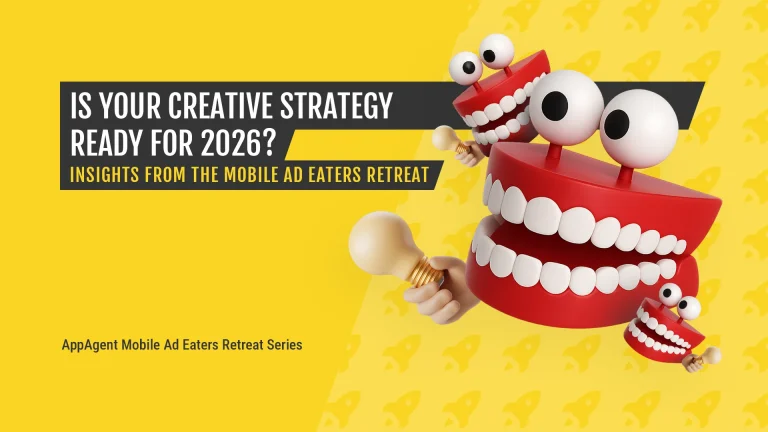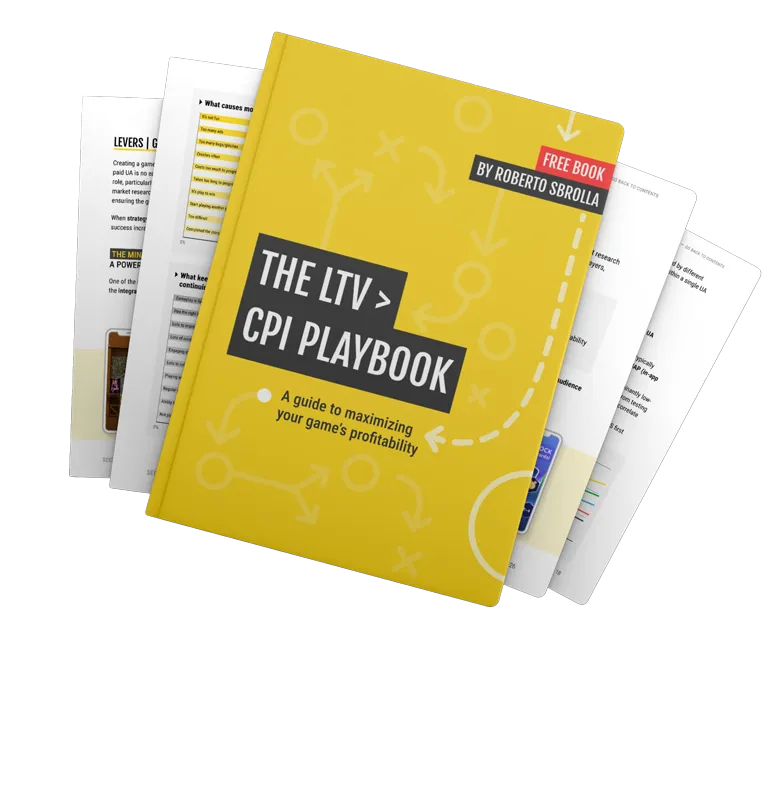This is part two of the Mobile Marketing Creatives Series. In ten episodes, we aim to provide insight and inspiration on creating thumb-stopping visuals to promote your app. In this episode we will focus on researching your competitors in order to increase app store conversion rate.

Download the Mobile Ad Creatives eBook today to read the other nine parts of this series. The comprehensive guide includes ten core topics condensed into a practical blueprint with examples from AppAgent’s Creative Team.
In this article, you will learn:
- The significance of grasping the competitive landscape to define your store’s position effectively in order to increase app store conversion rate.
- Techniques for observing and learning from your competitors’ strategies.
- How to use these insights in your own store listing experiments.
Why is Competition Analysis Important?
In the previous episode of this series, we discussed how some companies tend to overly focus on their competition rather than prioritizing their customers. However, it’s essential to keep the customer at the center of all marketing efforts.
That being said, understanding the competitive landscape is still crucial for your mobile app or game. It can assist you in defining a unique market position while always keeping the customer in mind. Remember, a balanced approach is key – putting customers first and being aware of your competitors’ strategies.
In the world of branding, Volvo is known for “Safety,” The North Face stands for “Exploring,” Candy Crush is a delightful “Tasty puzzle game,” and Clash Royale represents “Me against you,” a position defined by AppAgent.
These brands have unique propositions that set them apart. Copying others won’t work. It’s essential to understand how your competitors position themselves. This understanding will help you define your own unique selling proposition (USP). In the next episode, we explain how to create your USP.
How to Analyze your Competition using the App Store and Play Store
Start by identifying and mapping your direct competitors. These competitors could include games that offer a similar core gameplay experience or apps that fulfill specific user needs, such as food delivery or stock trading.
To learn more about what motivates users, check out episode one.
To identify your competitors, you can use store algorithms and explore suggestions like “You Might Also Like” in the App Store and “Similar Apps” in the Google Play Store. Also, check the charts in both stores to see which apps are popular in your category. Additionally, look for gaming YouTubers who would be a good fit for your title.
Once you have your list of competitors, focus on how each product presents itself in the app store and advertisements. You can use tools like Apptica or Facebook Ads Library to assist you with this.


Let’s illustrate this with a real-life example:
After completing the list of competitors, closely examine what they say about their app or game. It’s essential to understand not just what they say, but also how they say it. Explore how they execute their unique selling proposition and the key messages they use to support it.
To achieve this, you have two options:
1. CHECKING BEST-PERFORMING ADS
To identify successful ads from your competitors, you can use ad intelligence tools like Apptica. Look for ads with the highest number of impressions, as this indicates a larger marketing budget invested in the creative, often resulting in a positive return on ad spend. If the ad has been running for over a month, you can confidently say that your competitor has found an effective approach.
Here’s an example: In the Apptica screenshot below, you’ll notice a cinematic building ad that is responsible for nearly 87% of the impressions tracked for Forge of Empires, a game developed in Hamburg. This particular ad seems to be the best-performing one for the developer. For more valuable insights about this ad, you can watch Mobile Ad Eaters Episode 3, featuring Fabian Weiske from Innogames.
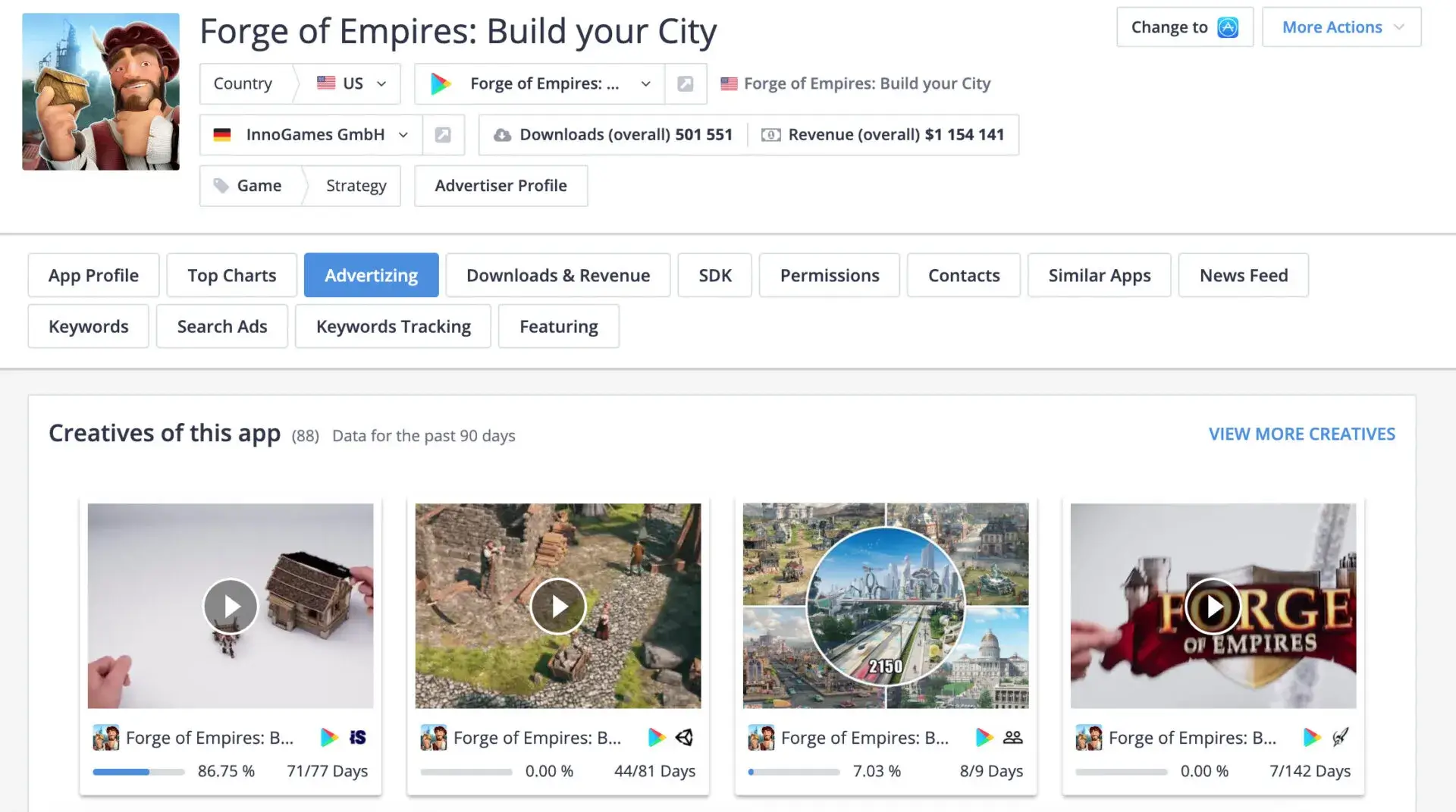
2. BY CHECKING BEST-PERFORMING STORE EXPERIMENTS
Not many people know that Apptweak, another frequently used tool at AppAgent, has a powerful feature called Timeline. This feature visually displays updates in the Google Play Store, including experiments conducted by app developers.
By utilizing Timeline, you can easily identify which experiments were applied to the main store listing. Analyzing long-term trends from these experiments can give you valuable insights into what works for your competition. You can gain confidence in understanding what messaging, art style, layout, copywriting, and other elements have proven effective for them. This information can be incredibly valuable for improving your own app’s performance and strategies.

By applying the techniques mentioned above, you can gather substantial information about your competitors, including their creative approaches and testing strategies. The next crucial step is to extract practical insights from this gathered material. Below, we have provided a practical example to illustrate this process.
Case Study on Insights Mining from Google Play Store Experiments
Suppose you are a publisher of a casual puzzle game, like Merge Mansion by Metacore, a Supercell-backed studio from Helsinki, and one of AppAgent’s clients. You are currently planning to update your game’s screenshots, and you believe that analyzing the puzzle category leader. Like the well-known Russian publisher Playrix, could provide valuable insights and inspiration for your revamp.
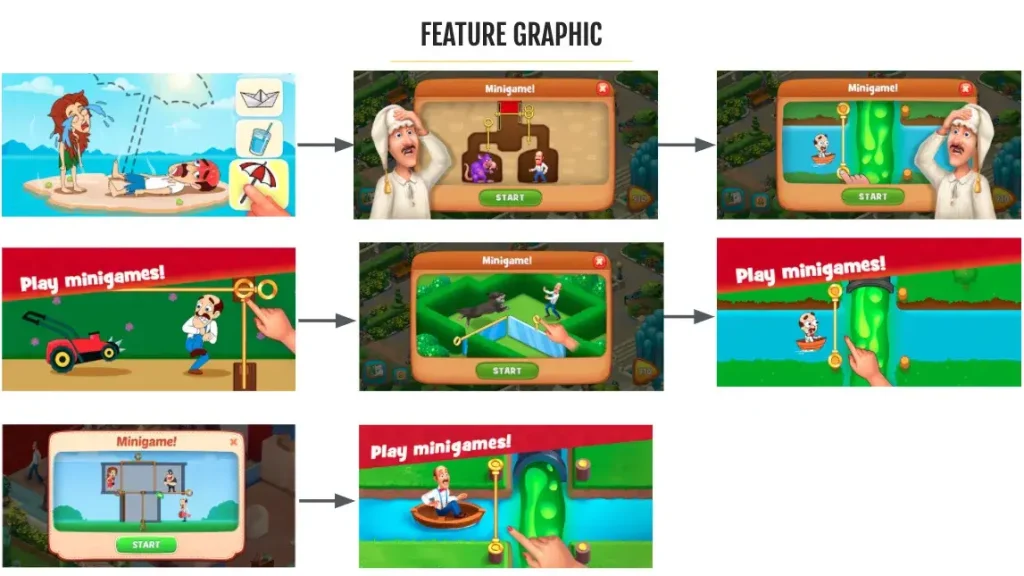
By examining your main competitor’s experiments, you can gain valuable insights into the assets they are testing. This analysis allows you to identify whether they use headlines in their screenshots, which parts of the game they emphasize in the first impression frame, the preferred character style that performs the best, and more.
When analyzing the feature art, you’ll notice that all of it is connected to their fake ads or minigames. This approach makes sense because the visual elements are located beside the icon, serving as the first thing store visitors see when coming from ads. It’s evident that Playrix aims to maintain a consistent user journey throughout all their visual assets.
The current store execution follows a simple and visually clear approach. All elements are enlarged, and the character design has a polished look, indicating that the previous small, cartoonish approach was not as effective. This careful analysis of their strategies can provide valuable lessons for your own game’s improvements.
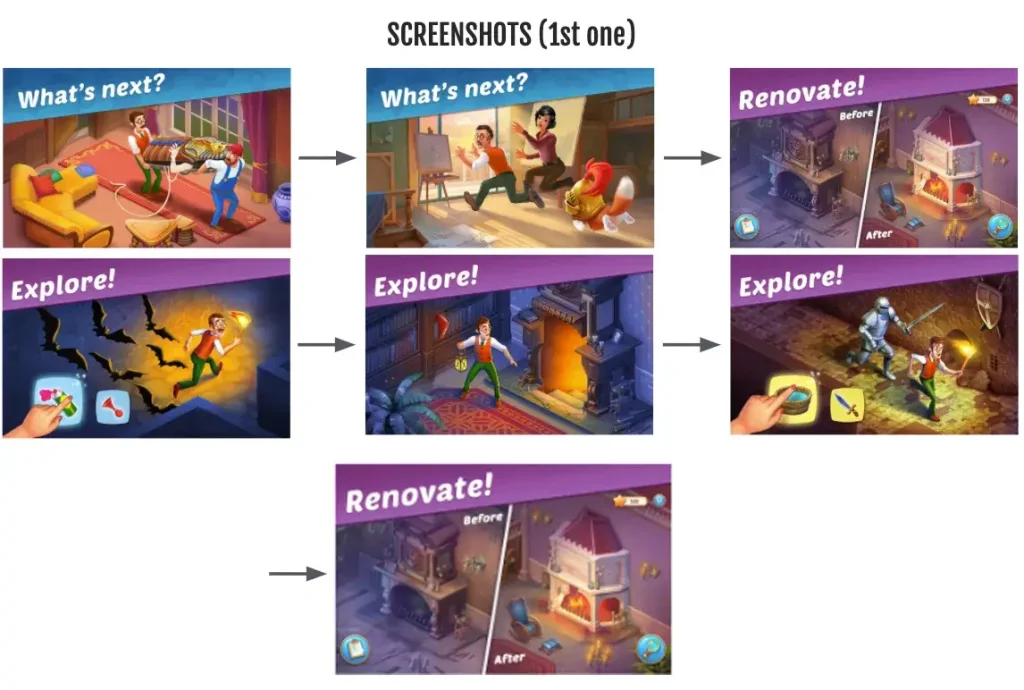
If we look at the first screenshot here, there is much more that we can learn:
First, Playrix focuses extensively on motivators, which you can read more about in the first part of this series. Each tested screenshot touches upon a strong emotion: whether it’s the excitement of moving your flat (“What’s Next?”), the process of decorating your new home, or the thrill of solving mysteries. If you explore the publisher’s complete portfolio, you’ll notice their laser-sharp focus on each element.
Single-Word Headlines. Why?
Another takeaway is that top-performing headlines typically consist of a single word. Playrix consistently employs this technique in various games, and even their competitors, like Tactile Games, follow suit.
Positioning the headline at the top left is crucial because people instinctively “read” screenshots from the top left to the bottom right. This valuable insight can greatly benefit designers!
Moreover, users are most captivated by the building and transformational elements. We found this aspect worth testing and used it as inspiration for the creative content of “Merge Mansion” ads (see one of the final ads by AppAgent).
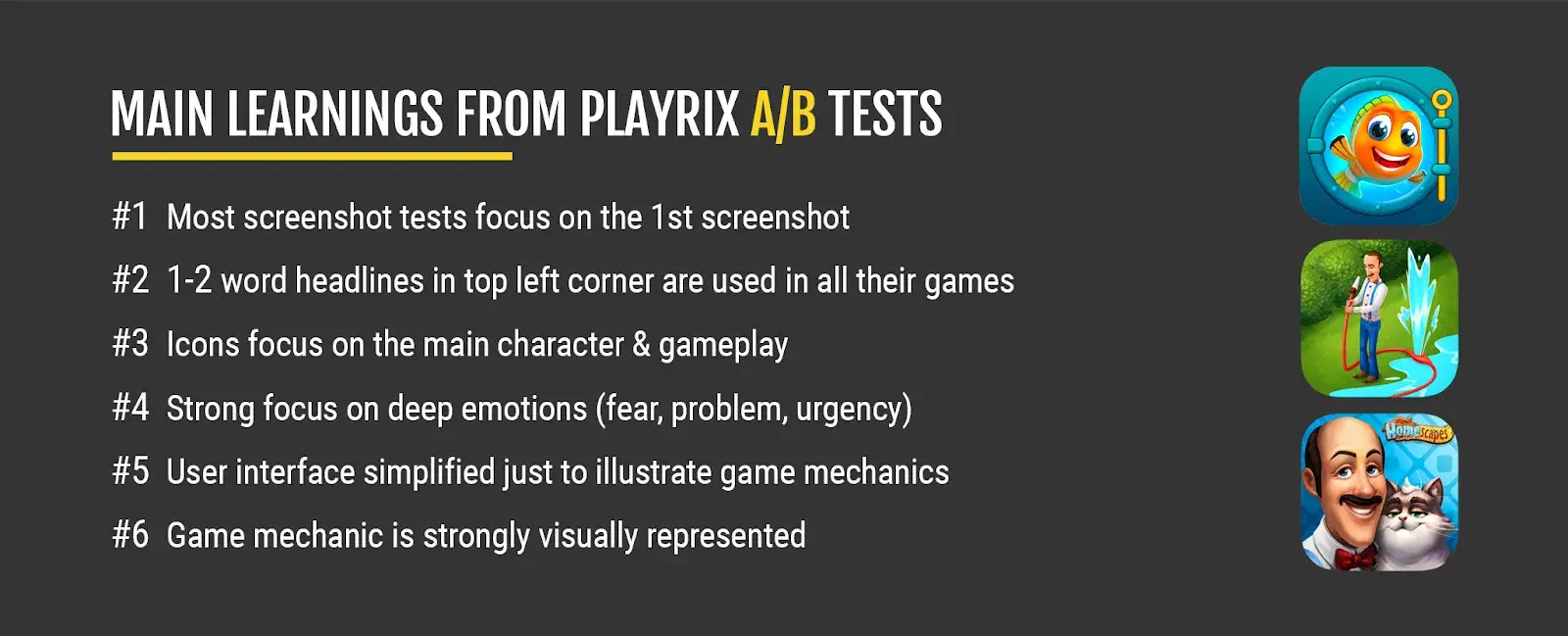
Once your research is finished, it’s essential to draw conclusions effectively. This will help you to start process to increase app store conversion rate. I suggest following this five-step approach to crafting your final synthesis.
- Observe patterns: Look for patterns within your category or among your direct competitors.
- Identify driving factors: Understand the reasons behind the success or failure of certain elements. Analyze how your customers might respond to specific messaging.
- Find inspiration: Create a mood board digitally or with printed samples to compile things that inspire you.
- Determine your unique approach: Clearly outline your thoughts and discuss observations with your team. Reflect on what aligns with your brand and audience, and use these insights to define an innovative and distinctive strategy.
- Summarize takeaways – Create a brief based on the main conclusions. Use this summary as a foundation for the ideation and design process.
My personal tip here is to complete these steps in a small team of two members. A creative and a marketing professional will naturally have different perspectives and hypotheses, which can bring a richness to the discussion and go a long way to finding the best angle for your product.
You must include these final take-aways into your creative strategy, creating a single document that is shared and used by all teams. Otherwise you risk that no matter how valuable insights are, they will get lost on your drive without practical use.
Lessons to Learn
As we have demonstrated, there are strategies that you can use to shorten your path to improving your top-of-the-funnel metrics, be it improving the click-through rate of your ads or increasing the install rate in the store.
Conducting competition research will help you to define your own “playfield” and provide valuable guidance to everyone involved in the creative process. It’s essential not to limit yourself too rigidly, as proper testing is the key to determining what truly works.
Mobile Ad Creatives eBook
How to Design Ads and App Store Creatives
A comprehensive guide to designing thumb-stopping visuals that will grow your user base and revenue.
How do you Increase App Store Conversion Rate?
Spy on competitors! Understanding them is critical at helping you to define a unique position in the market for your mobile app or game.
Begin by mapping your direct competitors, including those that offer the same experience, or fulfil the same motivators. Use the store algorithms, explore suggestions in the “You Might Also Like” in the App Store and “Similar Apps” in the Google Play Store. Check store’s charts to see what apps are most popular in your category.
Once you have compiled a list of competitors, focus on how each product presents itself in the stores by checking best performing ads and best-performing store experiments.
